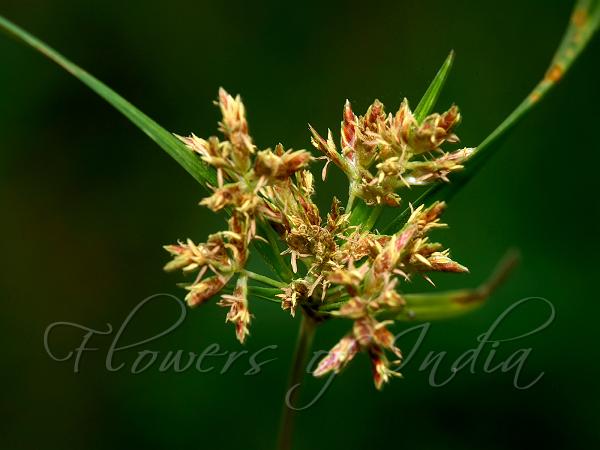|
| Rice Flat Sedge |
|

|

| File size | 340573 |
| Original date | 9/3/17 8:07 AM |
| Resolution | 1600 x 1200 |
| Flash | Flash did not fire, auto |
| Focal length | 150.0mm |
| Exposure time | 1/60s |
| Aperture | 14.0 |
| Focus Distance | |
| Metering Mode | Spot |
| Camera make | NIKON CORPORATION |
| Camera model | NIKON D800 |
| Sensor type | OneChipColorArea |
|
|
|
|
Photo: |
Botanical name: Cyperus iria Family: Cyperaceae (Sedge family)
Synonyms: Cyperus chrysomelinus, Cyperus microlepis, Cyperus resinosus
Synonyms: Cyperus chrysomelinus, Cyperus microlepis, Cyperus resinosus
Rice Flat Sedge is an erect, not clustered, annual
herb which doesn't form rhizomes. Stems (stems) are 12-50 cm tall,
three-sided. Leaves are few, basal, 10-50 x 3-6 mm, linear, flat,
gradually tapering, rough on upper margins; sheaths 1-3 cm long,
purplish-brown. Inflorescence are compound, 8-15 cm across, diffuse,
branches spike-like; leafy bracts 3-5, the longest upto 35 cm long.
Spikelets are 4-5 x 1.5-2 mm, linear-oblong, bearing 6-10 florets,
yellowish. Glumes are distant, 1-1.5 x 1-15 mm, obovate-round, tip
rounded or notched, keeled, yellowish, margins white-hyaline. Stamens
are 2-3. Stigmas 3. Nuts are 1-1.5 x about 0.5 mm, obovate,
triquetrous, stipitate, brown. Rice Flat Sedge is found in degraded
deciduous forests, marshy areas and paddy fields, in Tropical Asia and
East Africa. It is found in the Himalayas at altitudes of 200-1800 m.
Medicinal uses: The plant is astringent,
febrifuge, stimulant, stomachic and tonic. It is used to treat
amenorrhoea. The whole plant is used to treat rheumatism and to
regulate menstruation. The rhizomes are used as a diuretic. A decoction
of the ground tubers is used for treating fevers.
The plant is astringent,
febrifuge, stimulant, stomachic and tonic. It is used to treat
amenorrhoea. The whole plant is used to treat rheumatism and to
regulate menstruation. The rhizomes are used as a diuretic. A decoction
of the ground tubers is used for treating fevers.
Medicinal uses:
 The plant is astringent,
febrifuge, stimulant, stomachic and tonic. It is used to treat
amenorrhoea. The whole plant is used to treat rheumatism and to
regulate menstruation. The rhizomes are used as a diuretic. A decoction
of the ground tubers is used for treating fevers.
The plant is astringent,
febrifuge, stimulant, stomachic and tonic. It is used to treat
amenorrhoea. The whole plant is used to treat rheumatism and to
regulate menstruation. The rhizomes are used as a diuretic. A decoction
of the ground tubers is used for treating fevers. | Identification credit: Shashidharswamy Hiremath | Photographed in Karnataka & Manipur. |
• Is this flower misidentified? If yes,